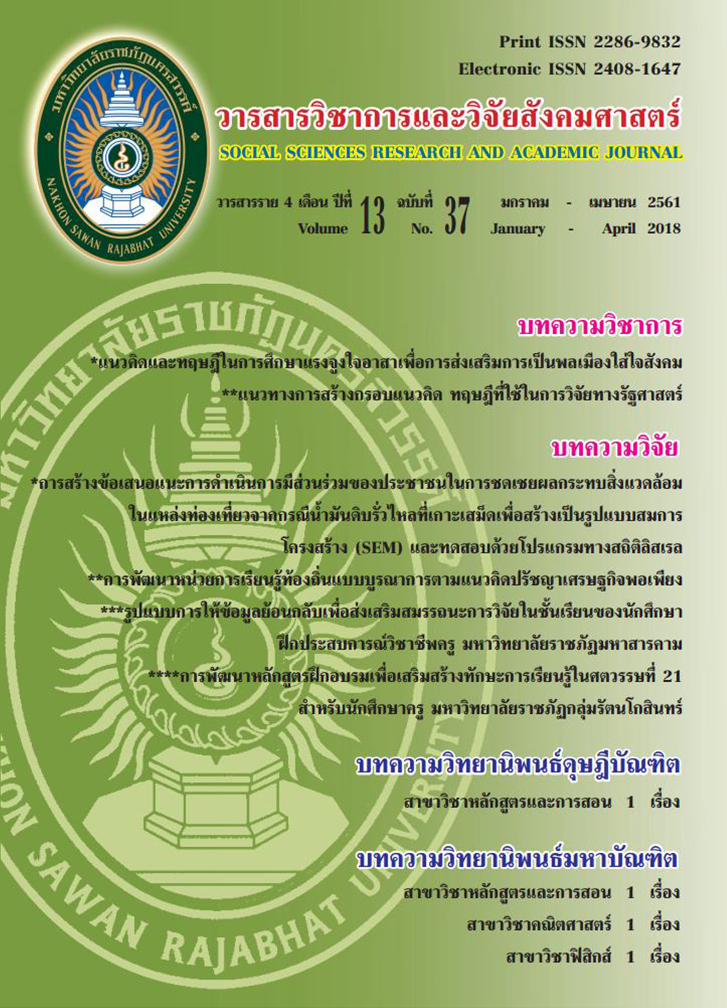การจัดการเรียนรู้โดยใช้กระบวนการออกแบบเชิงวิศวกรรมตามแนวคิดสะเต็มศึกษาเพื่อพัฒนาความคิดสร้างสรรค์ เรื่อง การเคลื่อนที่แบบหมุนของนักเรียนชั้นมัธยมศึกษาปีที่ 4 STEM Education Throhgh Engineering Design Process for Develioping 10 th Grade Students’ Creative Thinking in Rotational Motion Topic
Main Article Content
Abstract
ผลการวิจัยพบว่า การจัดการเรียนรู้โดยใช้กระบวนการออกแบบเชิงวิศวกรรมตามแนวคิดสะเต็มศึกษา ที่ช่วยพัฒนาความคิดสร้างสรรค์ มีลักษณะ ดังนี้ ขั้นระบุปัญหา การเลือกสถานการณ์ที่ใกล้ตัวและหลากหลายเพื่อให้นักเรียนได้วิเคราะห์ถึงปัญหาที่แท้จริง ขั้นจินตนาการวิธีการแก้ปัญหา ครูให้นักเรียนได้วางแผนก่อนที่จะค้นหาความรู้ที่เกี่ยวข้อง แล้วทำการสรุปโดยเขียนเป็นแผนผังความคิด ขั้นวางแผน ครูให้นักเรียนวาดภาพที่เคยเห็นมาก่อน เพื่อที่นักเรียนจะได้วาดภาพได้รวดเร็ว หลากหลาย แปลกใหม่ และกำหนดรายละเอียด พร้อมอธิบายถึงวิธีการสร้างได้ ขั้นสร้างสรรค์ชิ้นงาน ครูให้นักเรียนเปรียบเทียบชิ้นงานที่สร้างกับภาพร่างเพื่อให้เห็นถึงการเปลี่ยนแปลง และขั้นทดสอบและปรับปรุง ครูเน้นย้ำเรื่องการจดบันทึกสิ่งที่นักเรียนได้ทำการแก้ไขระหว่างการทดสอบประสิทธิภาพของชิ้นงาน เพื่อแสดงถึงการพัฒนาการของนักเรียนได้ ในส่วนของผลพัฒนาความคิดสร้างสรรค์ของนักเรียน พบว่า การจัดการเรียนรู้โดยใช้กระบวนการออกแบบเชิงวิศวกรรมตามแนวคิดสะเต็มศึกษาสามารถพัฒนาความคิดสร้างสรรค์ ในด้านความคิดยืดหยุ่นและด้านความคิดริเริ่ม
This research aims to investigate how to use stem education through engineering design process for developing creative thinking in rotational motion topic and to developing creative thinking of students by that method. This research utilizes a classroom action research. The participants in this research were 24 of 10th grade students with special abilities in science and math of a school in Phitsanulok. Research instruments consist of the lesson plans of stem education through engineering design process, creative thinking assessment and presentation. The data was analyzed by content analysis. The results showed that to use stem education through engineering design process consists of 5 steps by following 1) Identify; teacher chooses the situation that is closest and various for students to analyze 2) Imagine; students must plan detail before finding relevant knowledge. Then students summarize it by writing a thought map 3) Plan; students draw the picture they have seen before so that they are able to get faster, more various and more exquisite portraiture and describe how to create their 4) create; students compare works created to sketches for the observation of change and 5) Improve; teacher emphasizes on the recording of what they have done and been doing during the performance test in order to show the development of the students. In addition, the effect of developing creative thinking of students was flexibility and originality.
Article Details
References
ชลาธิป สมาหิติ. (2557). การจัดการศึกษาแบบบูรณาการวิทยาศาสตร์ เทคโนโลยีวิศวกรรมศาสตร์ และคณิตศาสตร์ (STEM) สำหรับเด็กปฐมวัย. กรุงเทพฯ: สมาคมอนุบาลแห่งประเทศไทย.
ชามาศ ดิษฐเจริญ และปริญญ์ ทนันชัยบัตร. (2557). การพัฒนาความคิดสร้างสรรค์และผลสัมฤทธิ์ทางการเรียนของนักเรียนชั้นมัธยมศึกษาปีที่ 6 โดยการจัดการเรียนรู้แบบโครงงานตามแนวคอนสตรัคชั่นนิซึ่ม ในรายวิชาการเขียนโปรแกรมพัฒนาหุ่นยนต์ประยุกต์. วารสารปัญญาภิวัฒน์. 5(2), 205-216.
ปุณฑริกา น้อยนนท์. (2560). การพัฒนารูปแบบการประเมินการเรียนรู้ในทศวรรษที่ 21 สำหรับสาระวิทยาศาสตร์ระดับชั้นมัธยมศึกษาปีที่ 4. วารสารวิชาการและวิจัยสังคมศาสตร์. 12(35), 57-72.
พิมพันธ์ เดชะคุปต์ และพเยาว์ ยินดีสุข. (2557). การจัดการเรียนรู้ในศตวรรษที่ 21. กรุงเทพฯ: โรงพิมพ์แห่งจุฬาลงกรณ์มหาวิทยาลัย.
ภัสสร ติดมา. (2558). การจัดการเรียนรู้ตามแนวทาง STEM Education เรื่องระบบของร่างกายมนุษย์ เพื่อส่งเสริมความคิดสร้างสรรค์ สำหรับนักเรียนชั้นมัธยมศึกษาปีที่ 2. วารสารราชพฤกษ์, 13(3), 71-76.
มณฑาทิพย์ ไชยศักดิ์. (2552). การพัฒนาความคิดสร้างสรรค์ในการบริหารการพยาบาล ใน บทความวิชาการการศึกษาต่อเนื่อง สาขาพยาบาลศาสตร์ เล่มที่ 8 การบริหารการพยาบาล. กรุงเทพฯ: ศิริยอดการพิมพ์.
วัชรี นวลผ่อง. (2553). การพัฒนาความคิดสร้างสรรค์ตามทฤษฎีการสร้างความรู้ เรื่อง งานประดิษฐ์จากภูมิปัญญาไทย วิชา งานประดิษฐ์ ชั้นมัธยมศึกษาปีที่ 6. วิทยานิพนธ์กาศึกษามหาบัณฑิต, วิทยาลัยมหาสารคาม, มหาสารคาม.
สถาบันวิจัยเพื่อพัฒนาประเทศไทย. (2557). การจัดทำยุทศาสตร์ปฏิรูปการศึกษาขั้นพื้นฐานให้เกิดความรับผิดชอบ. กรุงเทพฯ: สถาบันวิจัยเพื่อพัฒนาประเทศไทย.
สิรินภา กิจเกื้อกูล. (2557). การจัดการเรียนรู้วิทยาศาสตร์: ทิศทางสาหรับครูศตวรรษที่ 21. เพชรบูรณ์: โรงพิมพ์จุลดิสการพิมพ์.
สุพรรณี ชาญประเสริฐ. (2557). Active Learning การจัดการเรียนรู้ในศตวรรษที่ 21. นิตยสาร สสวท., 42(188), 4.
สนธิ พลชัยยา. (2557). สะเต็มศึกษากับการคิดขั้นสูง. นิตยสาร สสวท., 42(189), 7-8.
อภิสิทธิ์ ธงไชย และคณะ. (2556). สรุปการบรรยายพิเศษเรื่อง Science, Technology, Engineering, and Mathematics Education: Preparing studentsfor the 21st Century. สืบค้นเมื่อ 3 ตุลาคม 2559, จาก https://designtechnology.ipst.ac.th/uploads/STEMeducation.pdf.
อารี พันธ์มณี. (2557). ฝึกให้คิดเป็นคิดให้สร้างสรรค์. (พิมพ์ครั้งที่ 2). กรุงเทพฯ: ใยไหม.
Breiner, J.M., Johnson, C.C., Harkness, S.S. and Koehler, C.M. (2012). What is STEM? A discussion aboht conceptions of STEM in education and partnerships. Retrieved June 18, 2016, from http://onlinelibrary.wiley.com/doi/10.1111/j.1949-8594.2011.00109.x/abstract.
Kemmis, S. and McTaggart, R. (2000). Participatory action research. In N. Denzin & Y. Lincoln(Eds.), Handbook of qualitative research (2nd ed.). Thousand Oaks, CA: Sage.
Laura Greenstein. (2012). Assessing 21st Century Skills: A Guide to Evaluating Mastery and Authentic Learning. California: Corwin Press, Inc.
Morgan, J.R., Capraro, M.M. and Caprarp, R.M. (2013). STEM project-based learning: An integrated science, technology, engineering, and mathematics (STEM) approach. Rotterdam: Sense.
Roberts, A. (2013). STEM is here. Now what?. Technology and Engineering Teacher. 73(1), 22-27.
Schachter, R. (2012). A classroom of engineering: Teaching STEM in the younger grade. Scholastic Instructor. Retrieved June 9, 2014, from http://files.eric.ed.gov/fulltext/EJ973521.pdf.
Stohlmann, M., Moore, T.J. and Roehrig, G.H. (2012). Considerations for teaching integrated STEM education. Journal of Pre-College Engineering Education Research (J-PEER). 2(1), 28-34.

